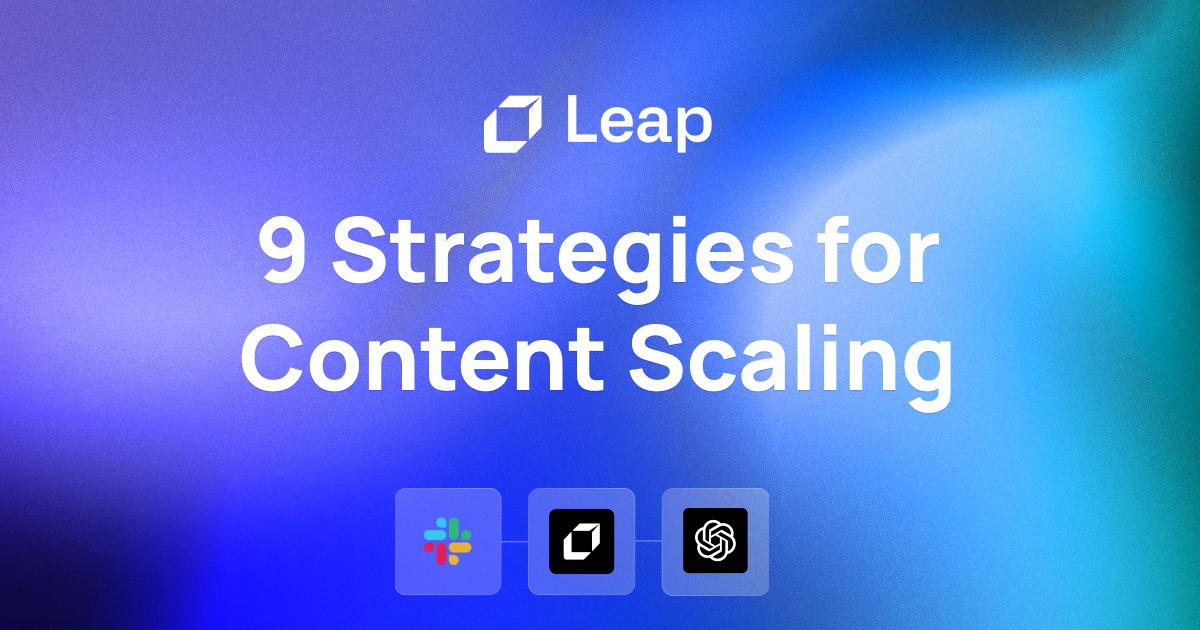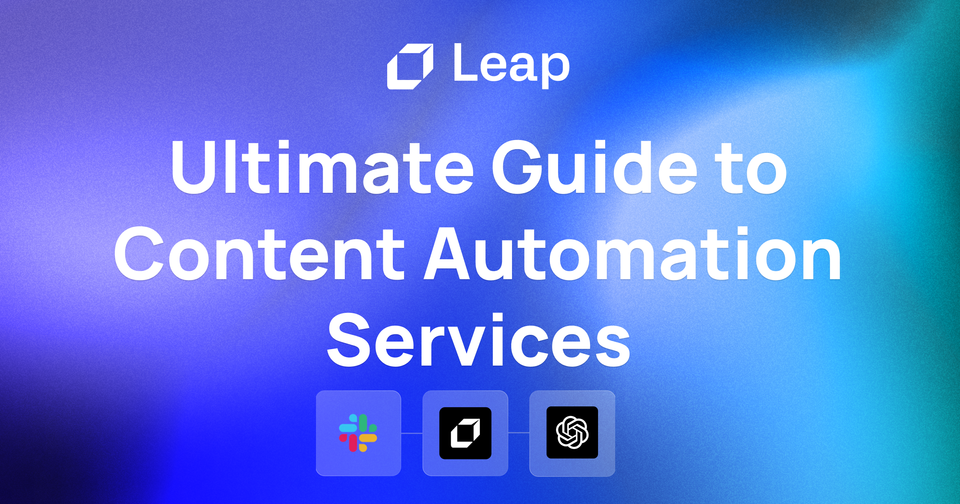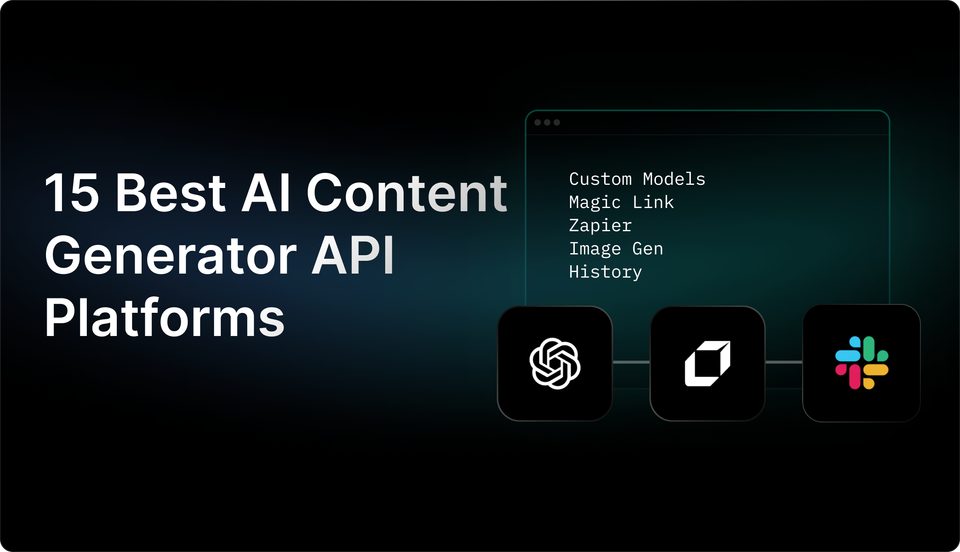9 Strategies for Successful Content Scaling in 2024
Content scaling is essential for growing your online presence. Discover nine key strategies that will take your content to the next level.

In the world of content scaling, creating high-quality content at a rapid pace can help businesses stay ahead in the digital race. Content scaling is essentially the process of creating and distributing a high volume of content across multiple platforms. By focusing on content scaling and content ideation, companies can increase their brand exposure, build credibility, and improve their website's visibility. Investing time and resources in content scaling can yield excellent results, which is why so many successful brands embrace this strategy.

What Is Content Scaling and Why Is It Important for Businesses?

1. Meeting Customer Demand
The ever-growing demand for content from customers necessitates businesses to create more content to engage with their target audience, enhance brand reputation, and potentially boost sales and profits.
2. Setting and Reaching Milestones
Content scaling helps businesses set and achieve specific milestones, like reaching a certain number of customers or revenue targets. These milestones guide strategic decision-making and lead the business towards its objectives.
3. Improving Efficiency
Scaling content can enhance overall business efficiency by streamlining processes, adopting new technologies, and optimizing workflows. These efficiencies lead to cost savings, heightened productivity, and better performance.
4. Staying Ahead of Competition
Effective content scaling enables businesses to stay ahead of competitors and maintain market dominance. It supports continuous growth, innovation, and adaptability in a dynamic business landscape.
5. Building Trust and Relationships
Content scaling plays a crucial role in fostering trust with customers by delivering consistent and valuable content. Trust is vital for customer loyalty and brand reputation, and scaling content allows businesses to establish and maintain robust relationships with their audience.
Leap helps you to automate your work with the power of AI
Partnered with Zapier, Vercel, and more, Leap enables you to supercharge your work by allowing you to create custom AI automations. Create sophisticated AI automations with no-code. Connect the tools you love with best-in-class AI text, image, and audio models.
Supercharge your existing tools with seamless AI integrations to OpenAI, Microsoft, and more. From summarizing documents, to voice translation, to AI call transcription, to AI avatar and asset generation, to SEO automation, to even automating the cold email creation and sending process, automate anything with Leap Workflows. The opportunities for automation are endless with Leap workflows.
Try Leap’s AI Workflows tool for free today.

Related Reading
How Do You Ensure a Successful and Efficient Content Scaling Process?

Efficiency plays a vital role in successful content scaling. Streamlining operations by automating repetitive tasks or non-core activities can help improve efficiency in content production. Implementing tools like content management systems (CMS) can help in organizing and streamlining the content production process. This can save time and reduce manual efforts to enable teams to focus more on creating quality content rather than on manual, repetitive tasks.
Quality Control for Consistent Content Standards
Ensuring consistent quality across all content pieces is crucial when scaling up. Quality control mechanisms, such as style guides and brand guidelines, can help in maintaining a uniform standard across content pieces. Periodic content audits can also help in identifying gaps, errors, or inconsistencies in content quality, ensuring that all content aligns with the defined quality standards.
Data-Driven Decisions for Informed Content Production
Using data analytics tools such as Google Analytics helps identify trends in user behavior, which can guide content production decisions. Analyzing user engagement metrics, content consumption patterns, and conversion rates can help in understanding what types of content resonate with the target audience, aiding in producing content that generates better results.
Diversification for Broadening Audience Engagement
Creating different types of content catering to various segments within the target market can expand reach and engagement. Diversifying content formats like blogs, videos, podcasts, infographics, etc., can appeal to different audience preferences and learning styles, ensuring a broader reach and increased engagement.
Resource Allocation for Efficient Content Production
As content production expands, allocating resources for tools, technologies, and personnel becomes essential to aid in content creation. Investing in content creation tools, marketing automation platforms, and training for team members can help in enhancing content production capabilities and ensuring that the content produced is of high quality and standards.
Time Management for Timely Content Delivery
Managing deadlines and ensuring the timely delivery of content becomes a challenge with increased workload, making effective time management crucial. Implementing project management tools, setting realistic timelines, and having clear communication channels can help in managing time effectively and delivering content on time.
Defining and Managing Roles for Efficient Scaling
Clearly defining roles and responsibilities within the content production team is vital for efficient scaling. Assigning clear ownership of tasks, roles, and responsibilities can help streamline the content production process, eliminating redundancy, and ensuring that each team member understands their role in the content creation workflow.
Promoting Good Governance for Brand Integrity
Safeguarding content quality and brand integrity is essential during the scaling process. Streamlining content processes and monitoring performance are key aspects of good governance. Implementing content approval workflows, content review processes, and quality assurance checks can help in maintaining content quality standards and ensuring that the content aligns with the brand values and guidelines.
9 Strategies for Successful Content Scaling

1. Repurposing High-Performing Content for Maximum Impact
Content scaling involves repurposing your top-performing content to increase its reach and impact. Regularly updating your best content to align with current trends and audience preferences is a key strategy in scaling content. It ensures that your content remains relevant, engaging, and continues to perform well over time.
2. Creating Detailed Buyer Personas to Tailor Content Effectively
Developing detailed buyer personas helps tailor content to the specific needs and preferences of different target audiences. This ensures that your content resonates with your audience and delivers value to them. By creating content that speaks directly to the needs and interests of different buyer personas, you can maximize the relevance and effectiveness of your content.
3. Efficient and Repetitive Workflows for Streamlined Content Creation
Developing efficient and repetitive workflows helps streamline the content creation process and maintain quality. By establishing clear processes and workflows for content creation, you can ensure consistency, efficiency, and quality in your content output. This allows you to scale content creation by eliminating inefficiencies and bottlenecks in the process.
4. Implementing a Brand Style Guide for Consistency and Brand Identity
Establishing a brand style guide ensures consistency across all content pieces and helps maintain brand identity. By defining key brand elements such as voice, tone, messaging, and visual style, you can ensure that all content aligns with your brand identity and guidelines. This consistency helps reinforce your brand image and messaging across all content types and channels.
5. Diversifying Content Types for Broad Audience Engagement
Producing a variety of content types helps address specific customer needs and engage a broader audience. By diversifying your content mix with formats such as blog posts, infographics, videos, and case studies, you can cater to different audience preferences and consumption habits. This variety helps you reach a wider audience and tailor content to different stages of the buyer's journey.
6. Setting Specific and Measurable Content Goals for Success
Defining specific, measurable goals for content creation helps drive traffic, improve SEO, showcase products/services, or engage specific audience segments. By setting clear goals for your content, you can track performance, measure success, and iterate on content strategies to achieve desired outcomes. This focus helps maximize the impact and effectiveness of your content scaling efforts.
7. Crafting a Clear Content Strategy and Vision for Alignment
Having a clear content strategy and vision guides content creation efforts and ensures alignment with business and client objectives. A well-defined content strategy helps provide direction, focus, and purpose to your content creation activities. It ensures that all content is created with a specific goal in mind and helps maintain consistency and coherence across your content output.
8. Enhancing User Experience with Varied Content
Enhancing user experience by catering to a diverse range of audience interests and needs through varied content types and topics. By producing content that addresses different user needs, questions, and interests, you can create a personalized and engaging user experience. This approach helps attract and retain users, build trust, and drive engagement with your content.
9. Optimizing SEO Performance through Content Scaling
Leveraging content scaling to improve SEO performance involves targeting keywords, answering user queries, and climbing search engine rankings. By creating high-quality, keyword-rich content at scale, you can improve your website's visibility and ranking on search engine results pages. This approach helps drive organic traffic, increase brand visibility, and attract qualified leads to your website.
AI Workflows
Leap helps you to automate your work with the power of AI. Partnered with Zapier, Vercel, and more, Leap enables you to supercharge your work by allowing you to create custom AI automations. Create sophisticated AI automations with no-code. Connect the tools you love with best-in-class AI text, image, and audio models.
Supercharge your existing tools with seamless AI integrations to OpenAI, Microsoft, and more. From summarizing documents, to voice translation, to AI call transcription, to AI avatar and asset generation, to SEO automation, to even automating the cold email creation and sending process, automate anything with Leap Workflows. The opportunities for automation are endless with Leap workflows.
Try Leap’s AI Workflows tool for free today.
Related Reading
- Content Automation
- Content Workflow
- Content Marketing Automation
- How To Make Ai Content Undetectable
- How To Train Chatgpt To Write Like You
- Content Marketing Workflow
- Best Instagram Automation
- Ai Powered Content Creation
- Ai Content Optimization
- Content Planning For Social Media
- Ai Content Management
- Ai And Content Marketing
- Content Production Process
- How To Automate Content Creation
- Automate Blog Posts
- Cost Effective Content Marketing
How To Measure Content Scaling Efforts

Traffic Growth
Monitoring website traffic metrics like page views, unique visitors, and session duration can indicate the success of content scaling in attracting more users to the site.
Lead Generation
Tracking the number of leads generated through content marketing efforts can help assess the effectiveness of scaling content production in converting visitors into potential customers.
Conversion Rates
Analyzing conversion rates from content-driven activities like downloads, sign-ups, or purchases can provide insights into how well content scaling is driving conversions and sales.
Engagement Metrics
Evaluating engagement metrics like social shares, comments, and time spent on content can indicate how well the audience is interacting with the increased volume of content.
Brand Loyalty
Assessing customer loyalty and brand sentiment through surveys, reviews, and social media mentions can help gauge the impact of content scaling on building brand trust and loyalty.
SEO Performance
Monitoring changes in search engine rankings, organic traffic, and keyword visibility can indicate the effectiveness of content scaling in improving SEO performance and visibility.
ROI Analysis
Calculating the return on investment (ROI) of content scaling efforts by comparing the costs incurred with the benefits gained, such as increased leads, sales, or brand awareness.
Enhancing Productivity with AI-Powered Workflows
Jumpstart your workflow and boost productivity with AI Workflows! Leap helps you to automate your work with the power of AI. Partnered with Zapier, Vercel, and more, Leap enables you to supercharge your work by allowing you to create custom AI automations. Create sophisticated AI automations with no-code. Connect the tools you love with best-in-class AI text, image, and audio models.
Supercharge your existing tools with seamless AI integrations to OpenAI, Microsoft, and more. From summarizing documents, to voice translation, to AI call transcription, to AI avatar and asset generation, to SEO automation, to even automating the cold email creation and sending process, automate anything with Leap Workflows. The opportunities for automation are endless with Leap workflows.
Try Leap’s AI Workflows tool for free today.
How to Choose the Right KPIs for Content Scaling Efforts

When it comes to content scaling, selecting the right Key Performance Indicators (KPIs) is crucial for measuring the success of your efforts. Here are some key considerations for choosing the appropriate KPIs to track the impact of content scaling on your goals and objectives.
Alignment with Business Goals
To evaluate the effectiveness of content scaling efforts, ensure that the KPIs you select align with your overarching business objectives and goals. By choosing KPIs that are directly related to your desired outcomes, you can track the impact of content scaling on the metrics that matter most to your business.
Specificity and Relevance
Opt for KPIs that are specific, measurable, attainable, relevant, and timely (SMART). These KPIs provide clear insights into the performance of your content scaling efforts, enabling you to track progress and make data-driven decisions to optimize your content strategy.
Content Performance Metrics
Include KPIs that measure content performance, such as click-through rate, bounce rate, time on page, and pages per session. These metrics help you evaluate user engagement and interaction with the content, providing valuable insights into how well your content resonates with your audience.
SEO and Search Visibility
Consider KPIs related to search engine optimization (SEO) performance, such as search ranking and overall search visibility. By tracking these metrics, you can assess the impact of content scaling on brand visibility and organic traffic, helping you optimize your content for better search performance.
Conversion and Lead Generation
Incorporate KPIs that track conversions, lead generation, and customer acquisition. These metrics help you evaluate the effectiveness of content scaling in driving desired actions and business growth, providing valuable insights into how well your content converts leads into customers.
Engagement Metrics
Include KPIs like click-through rate, bounce rate, time on page, and pages per session to measure user engagement and content effectiveness. These metrics help you assess how well your content captures and retains audience attention, enabling you to optimize your content for better engagement and interaction.
Brand Awareness and Loyalty
Consider KPIs that assess brand awareness, loyalty, and customer retention. These metrics help you gauge the impact of content scaling on building brand reputation and customer relationships, providing valuable insights into how well your content strategy aligns with your brand objectives.
Using AI Tools To Enhance Content Scaling Efforts
AI-powered tools like Leap AI, Jasper.ai, ChatPT, Synthesia, Hemingway Editor, Grammarly, and others enable content managers to create high-quality content quickly and efficiently, saving time and resources.
Enhanced Visual Content
AI-powered platforms can offer AI-powered video creation capabilities, allowing businesses to produce videos from plain text in multiple languages, saving time and budget while maintaining quality.
SEO Optimization
AI tools such as SurferSEO, Frase.io, and Keyword Insights AI assist in optimizing content for search engines by providing insights on keyword research, content optimization, search intent analysis, and competitor keyword analysis, enhancing SEO performance.
Content Optimization
GrowthBar, powered by GPT-4, simplifies keyword research, generates SEO-focused content suggestions, and offers competitive intelligence, aiding in the creation of SEO-friendly content.
Personalization and Brand Voice
AI-powered automation tools, including digital asset management systems, help in maintaining consistency in tone, style, and brand voice across high volumes of content, ensuring personalized and brand-aligned content at scale.
Collaborative Content Creation
Creative collaboration tools and shared assets facilitate efficient content creation by enabling teams to work together seamlessly, ensuring consistency and quality across content operations.
Leap helps you to automate your work with the power of AI
Partnered with Zapier, Vercel, and more, Leap enables you to supercharge your work by allowing you to create custom AI automations. Create sophisticated AI automations with no-code. Connect the tools you love with best-in-class AI text, image, and audio models.
Supercharge your existing tools with seamless AI integrations to OpenAI, Microsoft, and more. From summarizing documents, to voice translation, to AI call transcription, to AI avatar and asset generation, to SEO automation, to even automating the cold email creation and sending process, automate anything with Leap Workflows. The opportunities for automation are endless with Leap workflows.
Try Leap’s AI Workflows tool for free today.
Related Reading
- Midjourney Alternatives
- Ai Content Creation Tools
- Best Linkedin Automation Tools
- Social Media Automation Tools
- Content Automation Tools
- Writesonic Alternative
- Copy Ai Alternatives
- Jasper Ai Alternative
- Rytr Alternatives
- Wordtune Alternatives
- Ai Content Generator Api
- Content Automation Services
- Frase Alternative
Create Game Changing Automations Today With Leap’s AI Workflows
Content scaling plays a crucial role in the success of any business. Leveraging cutting-edge AI technologies can help streamline and optimize content scaling efforts significantly. Leap, for instance, is the perfect tool to achieve this.
With Leap, you can effortlessly automate your work using the power of AI. By teaming up with renowned platforms like Zapier and Vercel, Leap helps you supercharge your work by creating custom AI automations with zero coding required.
Connecting the Tools You Love with AI Models
One of the key advantages of Leap is its ability to connect the tools you already use with top-notch AI text, image, and audio models. By integrating these AI models into your existing tools, you can enhance their capabilities and streamline your content scaling processes.
Imagine being able to summarize documents, translate voice recordings, transcribe call recordings, generate AI avatars and assets, automate SEO tasks, or even create and send cold emails automatically. With Leap, these opportunities for automation are truly endless.
Expanding AI Integrations
Leap allows you to expand your AI integrations seamlessly. By integrating with OpenAI, Microsoft, and more, you can take advantage of a wide range of AI tools to enhance your content scaling efforts.
Whether you need to automate content creation, optimize SEO, or streamline your email marketing campaigns, Leap has the AI workflows you need to achieve your goals efficiently and effortlessly. Ready to take your content scaling to the next level?
Try Leap’s AI Workflows tool for free today.




